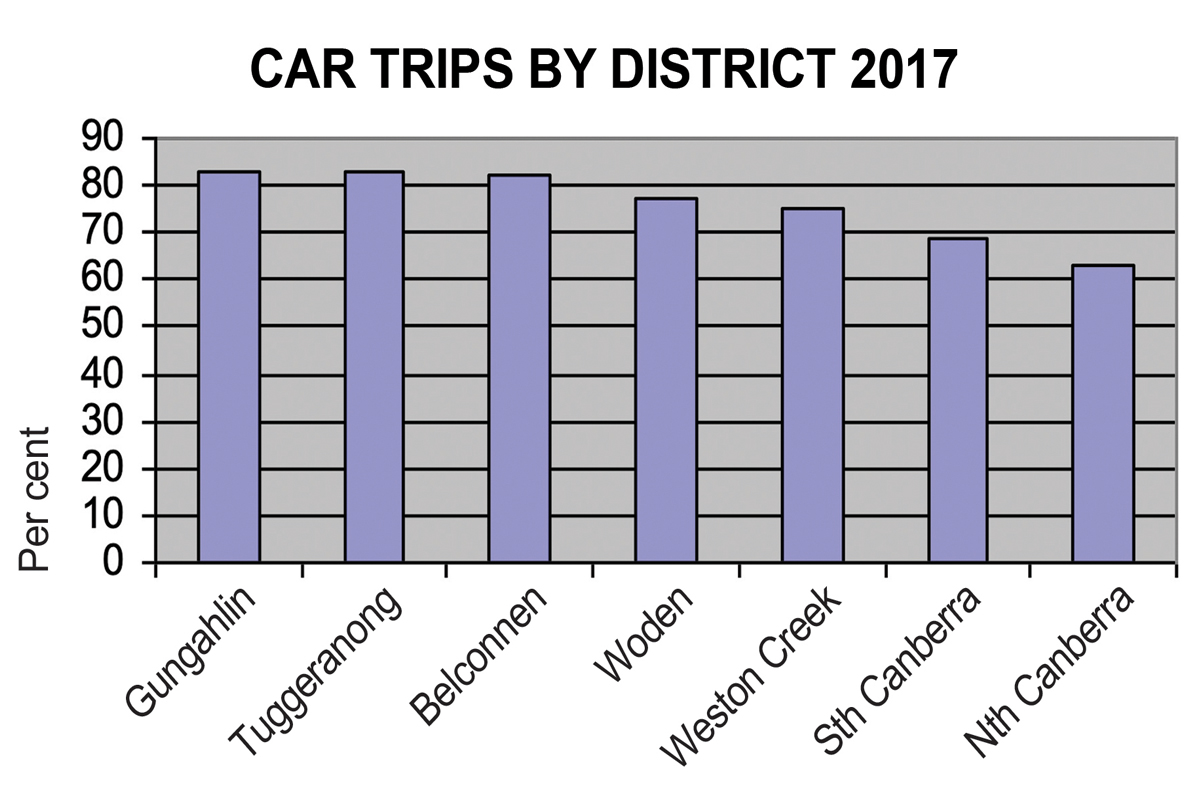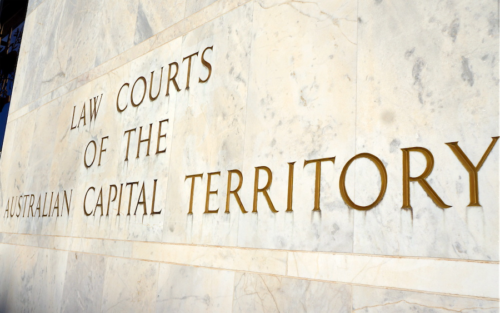“The ACT government’s public transport, city development and climate objectives could be achieved by a more rapid electrification of the bus fleet and increasing the frequency, comfort, speed and coverage of buses,” writes MIKE QUIRK.
IMPROVING Canberra’s bus system has lower risk and would be more effective in reducing car use and addressing future travel demand than light rail.

Lower car use is necessary to reduce greenhouse emissions, the cost of accidents, oil imports and pollution. However, the car will continue to be the main mode for most purposes as it is difficult for public transport and other modes to compete with its convenience, comfort, trip time and flexibility.
Data from the 2017 ACT and Queanbeyan-Palerang Household Travel Survey indicate of the 1.3 million trips made each day, 77 per cent were by car with the proportion of trips varying from 63 per cent in south Canberra to 83 per cent in Gungahlin (see chart).
While the reduction in car use will be assisted by investment in cycleway and pedestrian infrastructure and optimising the location of housing and employment, improving public transport is the main focus.
The late Paul Mees in his 2011 submission to Transport for Canberra, said the substantial upgrading of bus routes, service levels and vehicles and cycleway improvements in the late 1970s, resulted in the public transport mode share reaching 9.9 per cent in 1991 and an increase in cycling.
With self government, public transport use fell when operating subsidies for bus services were reduced and services cut sharply. The bus system was unable to deliver fast, frequent and reliable services and by 2001 the public transport mode share had declined to 6.7 per cent. The public transport mode share increased to 7.1 per cent in 2016 but in 2021 it had fallen to 6 per cent (with the share affected by the increase in working from home).
Based on Canberra’s experience from 1973 to the early 1990s, Mees argued Canberra should adopt a service model that focused on efficiently providing fast, high-frequency, fully integrated services across the whole of the city.
The Public Transport Association of Canberra, in its 2023-24 budget submission (with the major exception of its call for increased light rail services), reflects the views of Mees calling for more frequent bus services, timed connections, faster services and better integrated active travel. It identified more frequent bus services as a priority suggesting “a reasonable standard is every 10 minutes or better on rapid routes, 15 minutes in peak, 30 minutes off-peak weekdays, and 60 minutes late nights and weekends”.

In 2012, the ACT government adopted light rail and the first stage from Civic to Gungahlin opened in 2019. Light rail was adopted despite the government’s 2012 submission to Infrastructure Australia for Stage 1, comparing the cost with Bus Rapid Transit (BRT), finding BRT had twice the benefit to cost ratio (BCR) of light rail, would cost less than half to establish and provide the same stimulus of light rail.
The ACT government has costed the LR1 at $872m (at January, 2016 prices). Max Flint, from Smart Transport Canberra, calculated the real cost was $1.61 billion at January 2019 prices, not including $600 million to rehouse 1288 public tenants relocated from the corridor. He suggests the cost of Stage 2 to Woden could be in the order of $3 billion given its greater complexity.
The extension to Woden will have a journey time about twice that of the existing R4 and R5 buses, which will militate against patronage.
Extending light rail has a high degree of risk. The improvement in electric bus-based technologies could reduce the efficacy of light rail. Brisbane chose electric bus rapid transit for its Metro route as it was found to be two thirds the cost of light rail. The trackless tram, already in operation in China, may also be more cost-effective. A trial is to occur in the City of Stirling (Perth) later this year. The higher light rail peak-hour capacity may not be needed if the trend to increased working from home (which the ABS 2021 Census found increased from 3.1 per cent to 10.9 per cent between the 2016 and 2021) continues, reducing peak-hour demand. Improvements in autonomous vehicles could also limit the public transport capacity required.
There is also uncertainty about how crucial light rail will be in increasing density along the route. Increased higher-density housing in the Belconnen, Woden and Tuggeranong town centres and at Kingston in the absence of light rail suggest accessibility, not technology, is more important.
The transport investment also occurs in the context of competing spending priorities, with ACT debt forecast to be more than $8.6 billion in 2024/25, large unmet needs especially in social housing and health (let alone theatres, sports stadia) and the ability of buses to serve a greater number of employment locations must question the priority afforded light rail. More so when its transport, city development and climate objectives could be achieved by a more rapid electrification of the fleet and increasing the frequency, comfort, speed (assisted by additional transit lanes and BRT) and coverage of buses on feeder and inter-town routes. The prudent investment priority is buses not light rail.
Mike Quirk is a former NCDC and ACT government planner.
Who can be trusted?
In a world of spin and confusion, there’s never been a more important time to support independent journalism in Canberra.
If you trust our work online and want to enforce the power of independent voices, I invite you to make a small contribution.
Every dollar of support is invested back into our journalism to help keep citynews.com.au strong and free.
Thank you,
Ian Meikle, editor





Leave a Reply